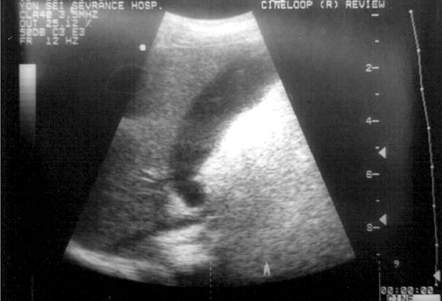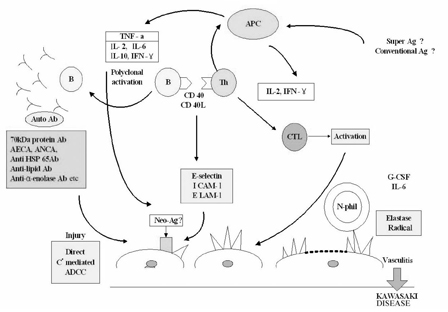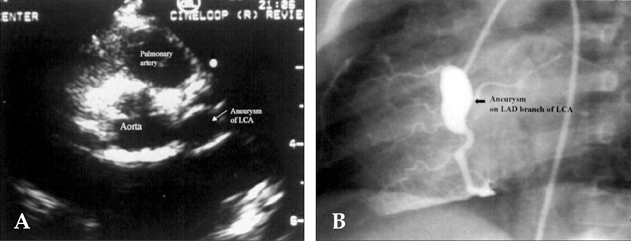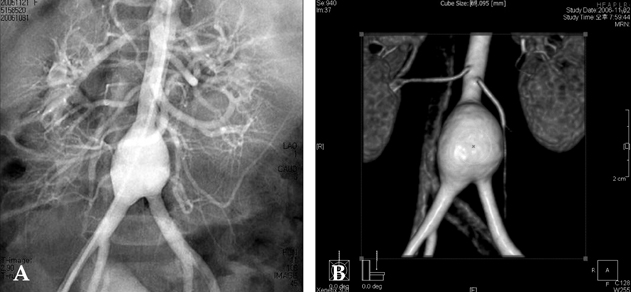Kawasaki Disease
- Affiliations
-
- 1Division of Infectious Disease and Immunology, Department of Pediatrics, Yonsei University College of Medicine, Severance Children's Hospital, Seoul, Korea. dskim6634@yumc.yonsei.ac.kr
- KMID: 1777163
- DOI: http://doi.org/10.3349/ymj.2006.47.6.759
Abstract
- Kawasaki disease is an acute febrile, systemic vasculitic syndrome of an unknown etiology that primarily occurs in children younger than five years of age. The principal presentations of Kawasaki disease include fever, bilateral nonexudative conjunctivitis, erythema of the lips and oral mucosa, changes in the extremities, rash, and cervical lymphadenopathy. Coronary artery aneurysms or ectasia develops in 15% to 25% of untreated children with the disease, which may later lead to myocardial infarction, sudden death, or ischemic heart disease. Treatment with intravenous gamma globulin (IVIG) is effective, but the mode of action is still unclear. The development of a diagnostic test, a more specific therapy, and ultimately the prevention of this potentially fatal illness in children are all dependent upon the continued advances in determining the etiopathogenesis of this fascinating disorder.
Keyword
MeSH Terms
Figure
Cited by 9 articles
-
Kawasaki Disease: Laboratory Findings and an Immunopathogenesis on the Premise of a "Protein Homeostasis System"
Kyung-Yil Lee, Jung-Woo Rhim, Jin-Han Kang
Yonsei Med J. 2012;53(2):262-275. doi: 10.3349/ymj.2012.53.2.262.Recent Advances in Kawasaki Disease
Kyu Yeun Kim, Dong Soo Kim
Yonsei Med J. 2016;57(1):15-21. doi: 10.3349/ymj.2016.57.1.15.Variants in the Gene EBF2 Are Associated with Kawasaki Disease in a Korean Population
Yoonsun Bae, Dongjik Shin, Jiho Nam, Hye Rim Lee, Jun Sung Kim, Kyu Yeun Kim, Dong Soo Kim, Yeun-Jun Chung
Yonsei Med J. 2018;59(4):519-523. doi: 10.3349/ymj.2018.59.4.519.A Case of Vitiligo after Kawasaki's Disease
Han Kyoung Cho, Lucy Youngmin Eun, Ji-Sun Song, Won Hyoung Kang, Byung In Ro
Ann Dermatol. 2009;21(1):75-77. doi: 10.5021/ad.2009.21.1.75.Prolonged Gallbladder Hydrops in a Kawasaki Disease Patient
Kyung Lim Yoon, Do Hee Kim, Mi Young Han, Sung Ho Cha, Hyun Cheol Kim
Adv Pediatr Surg. 2018;24(2):107-112. doi: 10.13029/aps.2018.24.2.107.Anterior Uveitis Associated with Kawasaki Disease-and the Ophthalmologist's Role
Mirinae Kim, Sun Young Kim
J Korean Ophthalmol Soc. 2016;57(2):296-301. doi: 10.3341/jkos.2016.57.2.296.ITPKC andSLC11A1 Gene Polymorphisms and Gene-Gene Interactions in Korean Patients with Kawasaki Disease
Kyu Yeun Kim, Yoon-Sun Bae, Woohyuk Ji, Dongjik Shin, Ho-Seong Kim, Dong Soo Kim
Yonsei Med J. 2018;59(1):119-127. doi: 10.3349/ymj.2018.59.1.119.Relation between Kawasaki Disease and Immunoglobulin E
Chung Mo Koo, Seong Yeol Choi, Dong Soo Kim, Ki Hwan Kim
J Rheum Dis. 2013;20(1):4-8. doi: 10.4078/jrd.2013.20.1.4.The Effect of Early Immunoglobulin Treatment on the Course of Kawasaki Disease
Chae Ik Ra, Ki Hwan Kim, Jong Gyun Ahn, Dong Soo Kim
J Korean Rheum Assoc. 2010;17(4):386-393. doi: 10.4078/jkra.2010.17.4.386.
Reference
-
1. Kawasaki T. Acute febrile mucocutaneous syndrome with lymphoid involvement with specific desquamation of the fingers and toes in children [in Japanese]. Arerugi. 1967. 16:178–222.2. Yamamoto T, Oya T, Watanabe A, et al. Clinical features of Kawasaki disease [in Japanese]. Shonika Rinsho (Jpn J Pediatr). 1968. 21:291–297.3. Kosaki F, Kawasaki T, Okawa S, et al. Clinicopathological conference on 10 fatal cases with acute febrile mucocutaneous lymph node syndrome [in Japanese]. Shonika Rinsho (Jpn J Pediatr). 1971. 24:2545–2559.4. Kawasaki T, Kosaki F, Okawa S, Shigematsu I, Yanagawa H. A new infantile acute febrile mucocutaneous lymph node syndrome (MLNS) prevailing in Japan. Pediatrics. 1974. 54:271–276.5. Burns JC, Wiggins JW Jr, Toews WH, Newburger JW, Leung DY, Wilson H, et al. Clinical spectrum of Kawasaki disease in infants younger than 6 months of age. J Pediatr. 1986. 109:759–763.6. Suddleson EA, Reid B, Woolley MM, Takahashi M. Hydrops of the gallbladder associated with Kawasaki syndrome. J Pediatr Surg. 1987. 22:956–959.7. Roh TW, Park MC, Kim DS. Antibody response against 65kD heat shock protein in Kawasaki disease [in Korean]. Pediatr Allergy Respir Dis. 1993. 3:68–72.8. Kim HY, Kim DS, Shin JS. NRAMP1 Gene Expression in Patients with Kawasaki Disease [in Korean]. Pediatr Allergy Respir Dis. 2000. 10:153–160.9. Kim HS, Noh GW, Kim DS, Lee KY, Lee HS, Lee HK, et al. Decreased CD5+ B cells during the acute phase of Kawasaki disease. Yonsei Med J. 1996. 37:52–58.10. Kim HY, Lee HG, Kim DS. Apoptosis of peripheral blood mononuclear cells in Kawasaki disease. J Rheumatol. 2000. 27:801–806.11. Dengler LD, Capparelli EV, Bastian JF, Bradley DJ, Glode MP, Santa S, et al. Cerebrospinal fluid profile in patients with acute Kawasaki disease. Pediatr Infect Dis J. 1998. 17:478–481.12. Okada T, Harada K, Okuni M. Serum HDL-cholesterol and lipoprotein fraction in Kawasaki disease (acute mucocutaneous lymph node syndrome). Jpn Circ J. 1982. 46:1039–1044.13. Newburger JW, Burns JC, Beiser AS, Loscalzo J. Altered lipid profile after Kawasaki syndrome. Circulation. 1991. 84:625–631.14. Cabana VG, Gidding SS, Getz GS, Chapman J, Shulman ST. Serum amyloid A and high density lipoprotein participate in the acute phase response of Kawasaki disease. Pediatr Res. 1997. 42:651–655.15. Rosenfeld EA, Corydon KE, Shulman ST. Kawasaki disease in infants less than one year of age. J Pediatr. 1995. 126:524–529.16. Momenah T, Sanatani S, Potts J, Sandor GG, Human DG, Patterson MW. Kawasaki disease in the older child. Pediatrics. 1998. 102:e7.17. Stockheim JA, Innocentini N, Shulman ST. Kawasaki disease in older children and adolescents. J Pediatr. 2000. 137:250–252.18. Yanagawa H, Nakamura Y, Yashiro M, Oki I, Hirata S, Zhang T, et al. Incidence survey of Kawasaki disease in 1997 and 1998 in Japan. Pediatrics. 2001. 107:E33.19. Holman RC, Curns AT, Belay ED, Steiner CA, Schonberger LB. Kawasaki syndrome hospitalizations in the United States, 1997 and 2000. Pediatrics. 2003. 112:495–501.20. Chang RK. The incidence of Kawasaki disease in the United States did not increase between 1988 and 1997. Pediatrics. 2003. 111:1124–1125.21. Park YW, Han JW, Park IS, Kim CH, Yun YS, Cha SH, et al. Epidemiologic picture of Kawasaki disease in Korea, 2000-2002. Pediatr Int. 2005. 47:382–387.22. Yanagawa H, Nakamura Y, Yashiro M, Ojima T, Tanihara S, Oki I, et al. Results of the nationwide epidemiologic survey of Kawasaki disease in 1995 and 1996 in Japan. Pediatrics. 1998. 102:E65.23. Fujita Y, Nakamura Y, Sakata K, Hara N, Kobayashi M, Nagai M, et al. Kawasaki disease in families. Pediatrics. 1989. 84:666–669.24. Harada F, Sada M, Kamiya T, Yanase Y, Kawasaki T, Sasazuki T. Genetic analysis of Kawasaki syndrome. Am J Hum Genet. 1986. 39:537–539.25. Yanagawa H, Yashiro M, Nakamura Y, Kawasaki T, Kato H. Epidemiologic pictures of Kawasaki disease in Japan: from the nationwide incidence survey in 1991 and 1992. Pediatrics. 1995. 95:475–479.26. Kaneko K, Obinata K, Katsumata K, Tawa T, Hosaka A, Yamashiro Y. Kawasaki disease in a father and daughter. Acta Paediatr. 1999. 88:791–792.27. Bruckheimer E, Bulbul Z, McCarthy P, Madri JA, Friedman AH, Hellenbrand WE. Images in cardiovascular medicine. Kawasaki disease: coronary aneurysms in mother and son. Circulation. 1998. 97:410–411.28. Uehara R, Yashiro M, Nakamura Y, Yanagawa H. Kawasaki disease in parents and children. Acta Paediatr. 2003. 92:694–697.29. Abe J, Kotzin BL, Jujo K, Melish ME, Glode MP, Kohsaka T, et al. Selective expansion of T cells expressing T-cell receptor variable regions V beta 2 and V beta 8 in Kawasaki disease. Proc Natl Acad Sci USA. 1992. 89:4066–4070.30. Kim DS, Han BH, Lee SK, Lee HK, Chwae YJ, Lee KY. Evidence for selection of 11 amino acid CDR3 domains in V kappa III-derived immunoglobulin light chains in Kawasaki disease. Scand J Rheumatol. 1997. 26:350–354.31. Leung DY, Giorno RC, Kazemi LV, Flynn PA, Busse JB. Evidence for superantigen involvement in cardiovascular injury due to Kawasaki syndrome. J Immunol. 1995. 155:5018–5021.32. Leung DY, Meissner HC, Shulman ST, Mason WH, Gerber MA, Glode MP, et al. Prevalence of super-antigen-secreting bacteria in patients with Kawasaki disease. J Pediatr. 2002. 140:742–746.33. Choi IH, Chwae YJ, Shim WS, Kim DS, Kwon DH, Kim JD, et al. Clonal expansion of CD8+ T cells in Kawasaki disease. J Immunol. 1997. 159:481–486.34. Rowley AH, Shulman ST, Spike BT, Mask CA, Baker SC. Oligoclonal IgA response in the vascular wall in acute Kawasaki disease. J Immunol. 2001. 166:1334–1343.35. Lee JS, Park IH, Shin JS, Kim DS. Clonal Expansion of Peripheral B Cells in Kawasaki Disease [in Korean]. Pediatr Allergy Respir Dis. 2002. 12:299–314.36. Shulman ST, Melish M, Inoue O, Kato H, Tomita S. Immunoglobulin allotypic markers in Kawasaki disease. J Pediatr. 1993. 122:84–86.37. Takeuchi K, Yamamoto K, Kataoka S, Kakihara T, Tanaka A, Sato S, et al. High incidence of angiotensin I converting enzyme genotype II in Kawasaki disease patients with coronary aneurysm. Eur J Pediatr. 1997. 156:266–268.38. Ahn SY, Jang GC, Shin JS, Shin KM, Kim DS. Tumor necrosis factor-alpha levels and promoter polymorphism in patients with Kawasaki disease in Korea. Yonsei Med J. 2003. 44:1021–1026.39. Huang Y, Lee YJ, Chen MR, Hsu CH, Lin SP, Sung TC, et al. Polymorphism of transmembrane region of MICA gene and Kawasaki disease. Exp Clin Immunogenet. 2000. 17:130–137.40. Tsukahara H, Hiraoka M, Saito M, Nishida K, Kobata R, Tsuchida S, et al. Methylenetetrahydrofolate reductase polymorphism in Kawasaki disease. Pediatr Int. 2000. 42:236–240.41. Jibiki T, Terai M, Shima M, Ogawa A, Hamada H, Kanazawa M, et al. Monocyte chemoattractant protein 1 gene regulatory region polymorphism and serum levels of monocyte chemoattractant protein 1 in Japanese patients with Kawasaki disease. Arthritis Rheum. 2001. 44:2211–2212.42. Sohn MH, Hur MW, Kim DS. Interleukin 6 gene promoter polymorphism is not associated with Kawasaki disease. Genes Immun. 2001. 2:357–362.43. Quasney MW, Bronstein DE, Cantor RM, Zhang Q, Stroupe C, Shike H, et al. Increased frequency of alleles associated with elevated tumor necrosis factor-alpha levels in children with Kawasaki disease. Pediatr Res. 2001. 49:686–690.44. Ouchi K, Suzuki Y, Shirakawa T, Kishi F. Polymorphism of SLC11A1 (formerly NRAMP1) gene confers susceptibility to Kawasaki disease. J Infect Dis. 2003. 187:326–329.45. Nishimura S, Zaitsu M, Hara M, Yokota G, Watanabe M, Ueda Y, et al. A polymorphism in the promoter of the CD14 gene (CD14/-159) is associated with the development of coronary artery lesions in patients with Kawasaki disease. J Pediatr. 2003. 143:357–362.46. Biezeveld MH, Kuipers IM, Geissler J, Lam J, Ottenkamp JJ, Hack CE, et al. Association of mannose-binding lectin genotype with cardiovascular abnormalities in Kawasaki disease. Lancet. 2003. 361:1268–1270.47. Naoe S, Takahashi K, Masuda H, Tanaka N. Kawasaki disease. With particular emphasis on arterial lesions. Acta Pathol Jpn. 1991. 41:785–797.48. Brown TJ, Crawford SE, Cornwall ML, Garcia F, Shulman ST, Rowley AH. CD8 T lymphocytes and macrophages infiltrate coronary artery aneurysms in acute Kawasaki disease. J Infect Dis. 2001. 184:940–943.49. Gavin PJ, Crawford SE, Shulman ST, Garcia FL, Rowley AH. Systemic arterial expression of matrix metalloproteinases 2 and 9 in acute Kawasaki disease. Arterioscler Thromb Vasc Biol. 2003. 23:576–581.50. Furukawa S, Matsubara T, Jujoh K, Yone K, Sugawara T, Sasai K, et al. Peripheral blood monocyte/macrophages and serum tumor necrosis factor in Kawasaki disease. Clin Immunol Immunopathol. 1988. 48:247–251.51. Maury CP, Salo E, Pelkonen P. Circulating interleukin-1 beta in patients with Kawasaki disease. N Engl J Med. 1988. 319:1670–1671.52. Kim DS. Serum interleukin-6 in Kawasaki disease. Yonsei Med J. 1992. 33:183–188.53. Jang GC, Kim HY, Ahn SY, Kim DS. Raised serum interleukin 15 levels in Kawasaki disease. Ann Rheum Dis. 2003. 62:264–266.54. Sohn MH, Noh SY, Chang W, Shin KM, Kim DS. Circulating interleukin 17 is increased in the acute stage of Kawasaki disease. Scand J Rheumatol. 2003. 32:364–366.55. Jang GC, Lee SY, Kim DS. Changes of Serum Interleukin-18 Levels in Kawasaki Disease [in Korean]. Pediatr Allergy Respir Dis. 2001. 11:130–137.56. Kim DS, Lee KY. Serum soluble E-selectin levels in Kawasaki disease. Scand J Rheumatol. 1994. 23:283–286.57. Rowley AH, Shulman ST, Mask CA, Finn LS, Terai M, Baker SC, et al. IgA plasma cell infiltration of proximal respiratory tract, pancreas, kidney, and coronary artery in acute Kawasaki disease. J Infect Dis. 2000. 182:1183–1191.58. Takeshita S, Tokutomi T, Kawase H, Nakatani K, Tsujimoto H, Kawamura Y, et al. Elevated serum levels of matrix metalloproteinase-9 (MMP-9) in Kawasaki disease. Clin Exp Immunol. 2001. 125:340–344.59. Wang CL, Wu YT, Liu CA, Lin MW, Lee CJ, Huang LT, et al. Expression of CD40 ligand on CD4+ T-cells and platelets correlated to the coronary artery lesion and disease progress in Kawasaki disease. Pediatrics. 2003. 111:E140–E147.60. Maeno N, Takei S, Masuda K, Akaike H, Matsuo K, Kitajima I, et al. Increased serum levels of vascular endothelial growth factor in Kawasaki disease. Pediatr Res. 1998. 44:596–599.61. Wong M, Silverman ED, Fish EN. Evidence for RANTES, monocyte chemotactic protein-1, and macrophage inflammatory protein-1 beta expression in Kawasaki disease. J Rheumatol. 1997. 24:1179–1185.62. Matsubara T, Furukawa S, Yabuta K. Serum levels of tumor necrosis factor, interleukin 2 receptor, and interferon-gamma in Kawasaki disease involved coronary-artery lesions. Clin Immunol Immunopathol. 1990. 56:29–36.63. Lin CY, Lin CC, Hwang B, Chiang B. Serial changes of serum interleukin-6, interleukin-8, and tumor necrosis factor alpha among patients with Kawasaki disease. J Pediatr. 1992. 121:924–926.64. Kim DS, Lee HK, Noh GW, Lee SI, Lee KY. Increased serum interleukin-10 level in Kawasaki disease. Yonsei Med J. 1996. 37:125–130.65. Kim KC, Kim DS. The soluble interleukin 2 receptor levels in Kawasaki disease [in Korean]. J Korean Pediatr Soc. 1992. 35:1657–1666.66. Hwang DH, Han JW, Choi KM, Shin KM, Kim DS. Expression of Toll-like Receptor-2 on the Peripheral Blood Monocytes in Kawasaki Disease Patients [in Korean]. J Korean Pediatr Soc. 2005. 48:315–320.67. Durongpisitkul K, Gururaj VJ, Park JM, Martin CF. The prevention of coronary artery aneurysm in Kawasaki disease: a meta-analysis on the efficacy of aspirin and immunoglobulin treatment. Pediatrics. 1995. 96:1057–1061.68. Furusho K, Kamiya T, Nakano H, Kiyosawa N, Shinomiya K, Hayashidera T, et al. High-dose intravenous gammaglobulin for Kawasaki disease. Lancet. 1984. 2:1055–1058.69. Newburger JW, Takahashi M, Burns JC, Beiser AS, Chung KJ, Duffy CE, et al. The treatment of Kawasaki syndrome with intravenous gamma globulin. N Engl J Med. 1986. 315:341–347.70. Morikawa Y, Ohashi Y, Harada K, Asai T, Okawa S, Nagashima M, et al. A multicenter, randomized, controlled trial of intravenous gamma globulin therapy in children with acute Kawasaki disease. Acta Paediatr Jpn. 1994. 36:347–354.71. Terai M, Shulman ST. Prevalence of coronary artery abnormalities in Kawasaki disease is highly dependent on gamma globulin dose but independent of salicylate dose. J Pediatr. 1997. 131:888–893.72. Lee HK, Kim DS, Noh GW, Lee KY. Effects of intravenous immune globulin on the peripheral lymphocyte phenotypes in Kawasaki disease. Yonsei Med J. 1996. 37:357–363.73. Xu C, Poirier B, Van Huyen JP, Lucchiari N, Michel O, Chevalier J, et al. Modulation of endothelial cell function by normal polyspecific human intravenous immunoglobulins: a possible mechanism of action in vascular diseases. Am J Pathol. 1998. 153:1257–1266.74. Sawaji Y, Haneda N, Yamaguchi S, Kajino Y, Kishida K, Seto S, et al. Coronary risk factors in acute Kawasaki disease: correlation of serum immunoglobulin levels with coronary complications. Acta Paediatr Jpn. 1998. 40:218–225.75. Zhang T, Yanagawa H, Oki I, Nakamura Y. Factors relating to the cardiac sequelae of Kawasaki disease one month after initial onset. Acta Paediatr. 2002. 91:517–520.76. Muta H, Ishii M, Egami K, Furui J, Sugahara Y, Akagi T, et al. Early intravenous gamma-globulin treatment for Kawasaki disease: the nationwide surveys in Japan. J Pediatr. 2004. 144:496–499.77. Marasini M, Pongiglione G, Gazzolo D, Campelli A, Ribaldone D, Caponnetto S. Late intravenous gamma globulin treatment in infants and children with Kawasaki disease and coronary artery abnormalities. Am J Cardiol. 1991. 68:796–797.78. Pickering LK. 2003 Report of the Committee on Infectious Diseases. Red Book. 2003. Chicago (IL): American Academy of Pediatrics.79. Kato H, Koike S, Yokoyama T. Kawasaki disease: effect of treatment on coronary artery involvement. Pediatrics. 1979. 63:175–179.80. Shinohara M, Sone K, Tomomasa T, Morikawa A. Corticosteroids in the treatment of the acute phase of Kawasaki disease. J Pediatr. 1999. 135:465–469.81. Sundel RP, Baker AL, Fulton DR, Newburger JW. Corticosteroids in the initial treatment of Kawasaki disease: report of a randomized trial. J Pediatr. 2003. 142:611–616.82. Okada Y, Shinohara M, Kobayashi T, Inoue Y, Tomomasa T, Kobayashi T, et al. Effect of corticosteroids in addition to intravenous gamma globulin therapy on serum cytokine levels in the acute phase of Kawasaki disease in children. J Pediatr. 2003. 143:363–367.83. Burns JC, Capparelli EV, Brown JA, Newburger JW, Glode MP. US/Canadian Kawasaki Syndrome Study Group. Intravenous gamma-globulin treatment and retreatment in Kawasaki disease. Pediatr Infect Dis J. 1998. 17:1144–1148.84. Wallace CA, French JW, Kahn SJ, Sherry DD. Initial intravenous gammaglobulin treatment failure in Kawasaki disease. Pediatrics. 2000. 105:E78.85. Newburger JW. Kawasaki disease: who is at risk? J Pediatr. 2000. 137:149–152.86. Wright DA, Newburger JW, Baker A, Sundel RP. Treatment of immune globulin-resistant Kawasaki disease with pulsed doses of corticosteroids. J Pediatr. 1996. 128:146–149.87. Takagi N, Kihara M, Yamaguchi S, Tamura K, Yabana M, Tokita Y, et al. Plasma exchange in Kawasaki disease. Lancet. 1995. 346:1307.88. Zaitsu M, Hamasaki Y, Tashiro K, Matsuo M, Ichimaru T, Fujita I, et al. Ulinastatin, an elastase inhibitor, inhibits the increased mRNA expression of prostaglandin H2 synthase-type 2 in Kawasaki disease. J Infect Dis. 2000. 181:1101–1109.89. Weiss JE, Eberhard BA, Chowdhury D, Gottlieb BS. Infliximab as a novel therapy for refractory Kawasaki disease. J Rheumatol. 2004. 31:808–810.90. Kuijpers TW, Biezeveld M, Achterhuis A, Kuipers I, Lam J, Hack CE, et al. Longstanding obliterative panarteritis in Kawasaki disease: lack of cyclosporin A effect. Pediatrics. 2003. 112:986–992.91. Ahn SY, Kim DS. Treatment of intravenous immunoglobulin-resistant Kawasaki disease with methotrexate. Scand J Rheumatol. 2005. 34:136–139.92. Lee MS, An SY, Jang GC, Kim DS. A case of intravenous immunoglobulin-resistant Kawasaki disease treated with methotrexate. Yonsei Med J. 2002. 43:527–532.93. O'Brien M, Parness IA, Neufeld EJ, Baker AL, Sundel RP, Newburger JW. Ticlopidine plus aspirin for coronary thrombosis in Kawasaki disease. Pediatrics. 2000. 105:E64.94. Williams RV, Wilke VM, Tani LY, Minich LL. Does Abciximab enhance regression of coronary aneurysms resulting from Kawasaki disease? Pediatrics. 2002. 109:E4.95. Suzuki A, Kamiya T, Kuwahara N, Ono Y, Kohata T, Takahashi O, et al. Coronary arterial lesions of Kawasaki disease: cardiac catheterization findings of 1100 cases. Pediatr Cardiol. 1986. 7:3–9.96. Dajani AS, Taubert KA, Takahashi M, Bierman FZ, Freed MD, Ferrieri P, et al. Guidelines for long-term management of patients with Kawasaki disease. Report from the Committee on Rheumatic Fever, Endocarditis, and Kawasaki Disease, Council on Cardiovascular Disease in the Young, American Heart Association. Circulation. 1994. 89:916–922.97. Akagi T, Kato H, Inoue O, Sato N, Imamura K. Valvular heart disease in Kawasaki syndrome: incidence and natural history. Am Heart J. 1990. 120:366–372.98. Yoshikawa J, Yanagihara K, Owaki T, Kato H, Takagi Y, Okumachi F, et al. Cross-sectional echocardiographic diagnosis of coronary artery aneurysms in patients with the mucocutaneous lymph node syndrome. Circulation. 1979. 59:133–139.99. Capannari TE, Daniels SR, Meyer RA, Schwartz DC, Kaplan S. Sensitivity, specificity and predictive value of two-dimensional echocardiography in detecting coronary artery aneurysms in patients with Kawasaki disease. J Am Coll Cardiol. 1986. 7:355–360.100. Kato H, Sugimura T, Akagi T, Sato N, Hashino K, Maeno Y, et al. Long-term consequences of Kawasaki disease. A 10- to 21-year follow-up study of 594 patients. Circulation. 1996. 94:1379–1385.101. Mori M, Imagawa T, Yasui K, Kanaya A, Yokota S. Predictors of coronary artery lesions after intravenous gamma-globulin treatment in Kawasaki disease. J Pediatr. 2000. 137:177–180.102. Asai T. Diagnosis and prognosis of coronary artery lesions in Kawasaki disease. Coronary angiography and the conditions for its application (a score chart) [Japanese]. Nippon Rinsho. 1983. 41:2080–2085.103. Koren G, Lavi S, Rose V, Rowe R. Kawasaki disease: review of risk factors for coronary aneurysms. J Pediatr. 1986. 108:388–392.104. Harada K. Intravenous gamma-globulin treatment in Kawasaki disease. Acta Paediatr Jpn. 1991. 33:805–810.105. Beiser AS, Takahashi M, Baker AL, Sundel RP, Newburger JW. US Multicenter Kawasaki Disease Study Group. A predictive instrument for coronary artery aneurysms in Kawasaki disease. Am J Cardiol. 1998. 81:1116–1120.106. Hwang DH, Sin KM, Choi KM, Choi JY, Sul JH, Kim DS. Statistical analysis of 1,000 cases of Kawasaki disease patients diagnosed at a single institute. Korean J Pediatr. 2005. 48:416–424.107. Takahashi M, Mason W, Lewis AB. Regression of coronary aneurysms in patients with Kawasaki syndrome. Circulation. 1987. 75:387–394.108. Fujiwara T, Fujiwara H, Hamashima Y. Size of coronary aneurysm as a determinant factor of the prognosis in Kawasaki disease: clinicopathologic study of coronary aneurysms. Prog Clin Biol Res. 1987. 250:519–520.109. Nakano H, Ueda K, Saito A, Nojima K. Repeated quantitative angiograms in coronary arterial aneurysm in Kawasaki disease. Am J Cardiol. 1985. 56:846–851.110. Ishii M, Ueno T, Akagi T, Baba K, Harada K, Hamaoka K, et al. Guidelines for catheter intervention in coronary artery lesion in Kawasaki disease. Pediatr Int. 2001. 43:558–562.111. Akagi T, Ogawa S, Ino T, Iwasa M, Echigo S, Kishida K, et al. Catheter interventional treatment in Kawasaki disease: a report from the Japanese Pediatric Interventional Cardiology Investigation group. J Pediatr. 2000. 137:181–186.112. Kitamura S. The role of coronary bypass operation on children with Kawasaki disease. Coron Artery Dis. 2002. 13:437–447.113. Checchia PA, Pahl E, Shaddy RE, Shulman ST. Cardiac transplantation for Kawasaki disease. Pediatrics. 1997. 100:695–699.114. Kamiya T, Suzuki A, Ono Y. In : Kato H, editor. Angiographic follow-up study of coronary artery lesion in the cases with a history of Kawasaki disease-with a focus on the follow-up more than ten years after the onset of the disease. Kawasaki Disease. 1995. Proceedings of the 5th International Kawasaki Disease Symposium; May 22-25, 1995; Fukuoka, Japan. New York (NY): Elsevier Science;569–573.115. Fujiwara T, Fujiwara H, Hamashima Y. Frequency and size of coronary arterial aneurysm at necropsy in Kawasaki disease. Am J Cardiol. 1987. 59:808–811.116. Nakano H, Saito A, Ueda K, Nojima K. Clinical characteristics of myocardial infarction following Kawasaki disease: report of 11 cases. J Pediatr. 1986. 108:198–203.117. Tatara K, Kusakawa S. Long-term prognosis of giant coronary aneurysm in Kawasaki disease: an angiographic study. J Pediatr. 1987. 111:705–710.118. Kato H, Ichinose E, Kawasaki T. Myocardial infarction in Kawasaki disease: clinical analyses in 195 cases. J Pediatr. 1986. 108:923–927.119. Furukawa S, Matsubara T, Umezawa Y, Okumura K, Yabuta K. Serum levels of p60 soluble tumor necrosis factor receptor during acute Kawasaki disease. J Pediatr. 1994. 124:721–725.120. Matsubara T, Umezawa Y, Tsuru S, Motohashi T, Yabuta K, Furukawa S. Decrease in the concentrations of transforming growth factor-beta 1 in the sera of patients with Kawasaki disease. Scand J Rheumatol. 1997. 26:314–317.121. Lee TJ, Chun JK, Yeon SI, Shin JS, Kim DS. Increased serum levels of macrophage migration inhibitory factor in patients with Kawasaki disease. Scand J Rheumatol. 2006. In press.122. Leung DY, Collins T, Lapierre LA, Geha RS, Pober JS. Immunoglobulin M antibodies present in the acute phase of Kawasaki syndrome lyse cultured vascular endothelial cells stimulated by gamma interferon. J Clin Invest. 1986. 77:1428–1435.123. Mason WH, Jordan SC, Sakai R, Takahashi M, Bernstein B. Circulating immune complexes in Kawasaki syndrome. Pediatr Infect Dis. 1985. 4:48–51.124. Culora GA, Moore IE. Kawasaki disease, Epstein-Barr virus and coronary artery aneurysms. J Clin Pathol. 1997. 50:161–163.125. Burns JC, Glode MP, Clarke SH, Wiggins J Jr, Hathaway WE. Coagulopathy and platelet activation in Kawasaki syndrome: identification of patients at high risk for development of coronary artery aneurysms. J Pediatr. 1984. 105:206–211.126. Nash MC, Shah V, Reader JA, Dillon MJ. Anti-neutrophil cytoplasmic antibodies and anti-endothelial cell antibodies are not increased in Kawasaki disease. Br J Rheumatol. 1995. 34:882–887.







